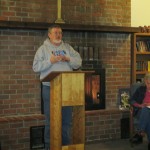Last post we discussed how to write powerful dialogue. But what about stuff that your characters are doing while the dialogue flows?
Writing Tip for Today: What are some ways to write active (as opposed to static) scenes?
Use the Wilson Principle!
The Wilson Principle is all about keeping your POV character from delivering soliloquies. Sure, Shakespeare got away with them, but in most fiction, getting another character on stage is the easiest way to make sure something happens in the scene. While it’s possible to write an active scene that really doesn’t go anywhere (I know, I’ve written them) if you get another character onstage (as Tom Hanks did in Castaway), it’s more likely that you will stay away from monologues which are usually sneaky ways for the author to write back story or provide too much information. By forcing your character to interact with someone, you will probably have a much easier time presenting the conflict and obstacles facing that character. And the reader will have an easier time reading too. A win-win.
Get Up from the Table!
Some of my students tease me about this, but I read so much student work that features scene after scene where characters are gathered around a table, sitting at a bar or some other way of sitting doing relatively little except talking. Smart writers know that a “table scene” limits the possibilities by only “showing” characters from the waist up and seeing the mouths move in speech or to occasionally sip their tea. A better way to compose a scene is to put your characters into motion. Maybe they’re mowing the yard, shucking corn or washing dishes. Present the scene’s purpose and conflict as these characters move about and the reader will be able to imagine a robust and active story. This is not to say you NEVER write a table scene. But do pay attention to how many you have and how close they are to each other. At the very least, try to use camera angles in an active way if you really need that table scene.
The Bad Screwdriver Rule: Link Emotions to Actions.
If you’ve ever thrown a tool when it refused to obey you, you know how easy it is to get mad at inanimate objects when you’re really mad at a person. Use a character’s actions to convey emotions and you’ve accomplished two things: One, you’ve “shown, not told,” and two, you keep the scene from becoming inactive or depending too heavily on other elements such as dialogue. Try these three tips for your next scene and prove to yourself that Michelle Obama is right about action: Let’s Move!





